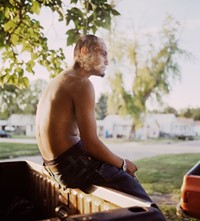Gregory Halpern ended up in Omaha, Nebraska by chance after graduating university. Intrigued by the culture of masculinity there, the photographer has returned regularly to photograph its residents over the last 15 years
- TextDaphne Milner
A quick Google search on masculinity offers an endless list of articles about what it means to be a man today – from heated discussions about toxic masculinity to countless explorations of modern-day manhood. Our understanding of manliness is neither definite nor universally determined. Rather, it is repeatedly being fractured, dissected and debated.
Magnum photographer Gregory Halpern has spent the past 15 years studying manifestations of American masculinity, the results appearing in his new book Omaha Sketchbook. Spread across loosely collaged pages which recreate the artist’s sketchbooks, Halpern’s photographs are a poignant reflection on the men living in Omaha, Nebraska, part of America’s heartland. For Halpern, it is his ambivalent relationship to conventional notions of manliness that both attracts him to and repels him from his subject matter, and it is this paradox that Omaha Sketchbook celebrates. Through lyrical portraits of young men and reflective shots of the city they live in, Halpern holds up a mirror for us to reconsider our understandings and expectations of gender. Omaha Sketchbook is in this sense a lyrical re-presentation of a subject in constant flux. Here, as an exhibition of the photographs opens in London, Halpern explains the story behind the series.
“I was a bit lost after I finished graduate school. I didn’t have much going on so I applied for a number of art residencies all over the United States and ended up getting one in Omaha, Nebraska. It was by chance that I wound up there but I became totally fascinated by the city and the culture. I took a job teaching photography at a community centre and stayed on for about six months after the residency ended. But even after I moved away, Omaha was always on the back burner – sometimes a year or two would go by but I would eventually go back.
“There’s something about the culture that was really foreign to me. Notions of masculinity, for example, were quite conventional. The values of how to be a boy or a man in my home were not particularly traditional so this difference both intrigued and repulsed me. I keep thinking about how the President is an embodiment of the type of man – historically speaking – that Americans celebrate. Donald Trump is a mixture of confidence and insecurity. It was this fine line between aggression and inadequacy that I wanted to explore in Omaha Sketchbook.
“My approach was probably a bit more simplistic to begin with. Maybe even judgemental. Then, as I got older, I realised that nothing is black or white; that I can be both attracted to and repelled by a traditionally masculinist culture. I realised that I didn’t really have to resolve this paradox. Creating a book that simply rejected an entire way of being would also seem too easy when nothing is that clear-cut in real life. The more I worked on Omaha Sketchbook, the more ready I became to embrace contradictory emotions.

“When I’m photographing I use the intuitive part of my brain that responds to anything I’m visually attracted to – it could the lighting or a person or even an object. Then the editing process is more reflective and analytical. When I return to the photographs later on, I find that it’s usually a contradiction of some sort that lends them an electricity. To give an example, this could be a tension between toughness and softness. Whereas if the subject is a total cliché I wouldn’t have to look at the picture more than once.
“I’ve been very cynical about politics lately and I question art’s ability to do something about the state of things. If anything, I hope Omaha Sketchbook creates a space in which men can look at themselves and reconsider their understanding of masculinity. But ultimately I want people to make up their own mind about what my pictures mean to them. I want the viewer to bring their experiences and feelings to the photographs and to engage with the subject in their own way.”
Omaha Sketchbook is available now, published by MACK. An exhibition of the same name is open at Huxley-Parlour Gallery, London, from September 19 – October 12, 2019.















